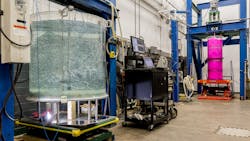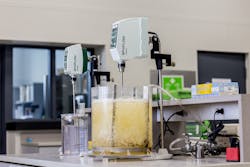6 things process engineers should consider when scaling up (or down) mixing processes
When designing new mixing processes, it is often necessary to either scale up or scale down. Scaling up is a necessary step in the design of a new mixing process, which should use both computational and experimental methods to justify the approach. Combining these methods with past experience and published literature often yield the best result. But when embarking on scaling a mixing process, what should process engineers consider?
Let us first touch briefly on the reason for scaling down a process. This may be required if a process is not working well, as a practical approach to reproduce problems and test possible fixes in an experimental setting. Scaling down may also be part of a wider process benchmarking or optimization exercise.
Whether scaling up or down, the methods used varies based on factors, such as the application and the use of fluids with complex rheologies that may include solids and gas. The Handbook of Industrial Mixing, which was published in 2004, as well as Advances in Industrial Mixing, which was published in 2016, are great resources to investigate fluid mixing, coupled with the application and scale-up knowledge of agitator manufacturers. But even with close to 100 years of mixing application experience, SPX FLOW Lightnin’s sizing procedures do not cover every new application being developed. Process engineers should consider these six steps:
1. Ensure geometric similarity
It may seem obvious, but process engineers must consider the shape of the tank, the location of the impellers, the placement of the anti-swirl wall baffles and the mixer mounting arrangement (top, side, bottom, on center, off center, etc.) You can use 3D printing technology to produce impellers geometrically similar to full-scale counterparts, but even if the overall diameter-to-tank ratio (D/T) is similar, be cautious about whether lab-scale impellers will perform the same as when they are full-size. If the measurement of impeller diameter over tank width deviates by more than 5%, this can affect scale-up predictions, especially if starting with a large D/T of more than 0.4. The effect of continuous sampling or probes on the flow pattern in the small scale should also be taken into consideration because they can act like a baffle, especially if the tank size is small.
2. What scale to use?
Right from the start, it is important to understand how large of a volume will be mixed at full scale so you can select the appropriate volume in the small scale. Typically, the smallest vessels for testing should be 12 to 18 inches in diameter. For multi-phase applications, especially when evaluating gas dispersion, a larger scale vessel should be considered and 24 inches should be considered the minimum size. New formulations are often performed in the beaker-size scale by many companies (1,000 to 4,000 mL), but that will not address all the hydrodynamics concerns related to mixing the product.
3. Kinematic similarity will not a give a complete picture
Velocity in the mixing vessel is related to the tip speed of the impeller, which is the peripheral speed of the tip of the impeller at a given rpm. If this is kept constant as the process is scaled up, the velocity field in small scale will look similar to the velocity field at large scale. The distances involved in traveling from points within the large-scale vessel are much larger, thus blend time increased dramatically by scaling with this method alone. Scaling up using tip speed will also mean a much lower energy level and less turbulence within the flow field, especially near the impeller and the vessel floor. This will negatively impact solids suspension at the bottom of the tank and can adversely affect controlling both chemical reactions within the flow field and dispersion of a gas.
4. Consider dynamic similarity
If the system is geometrically similar, process engineers must consider how the mixer energy is dissipated within the volume, because the combination of mixer energy with a particular flow pattern leads to a desired mixing result. It is important to consider dimensionless numbers from classical fluid mechanics, such as the Reynolds number, Froude number and Weber number. The Reynolds number is the ratio of the inertial forces created by the impeller on the fluid versus the viscous forces trying to stop the fluid from moving. The Froude number is the ratio of the inertial forces created by the impeller on the fluid versus the gravitational forces acting on the fluid. Finally, the Weber number is the ratio of the inertial forces created by the impeller on the fluid versus the effect of surface tension of the fluid. All these force ratios, coupled with the power density and circulation, should be used together to scale up and down mixing processes for different applications.
5. The flow pattern is important
Impellers create different flow patterns depending on the Reynolds number they operate at. At a Reynolds number over 10,000, there is turbulent flow. Transitional flows are between 50 and 10,000 (with noticeable changes starting to occur lower than 1,000) and laminar flows are less than 50. Thicker fluids will create less circulation, and impellers will behave differently as the scale of the process changes. The best way to fully illustrate the scale-up method is to combine the use of experimentation and Computational Flow Dynamics (CFD).
If surface effects, such as vortices, are important, the Froude number must be maintained across scales while matching flow regime (turbulent vs. transitional vs. laminar) as closely as possible. An impeller’s ability to disperse gas in a liquid also scales with the Froude number. Again, if the Reynolds number is kept similar, this helps predict the gas dispersion of an impeller across scales. For immiscible liquid dispersions and applications that require a certain drop size, it is more important to compare the Weber number across scales. Immiscible dispersions and emulsions, however, require additional comparisons that are typically rather complex.
Ultimately, all these dimensionless numbers are significant, but they cannot be considered in isolation. Practical scale-up requires process engineers to understand what factors dominate the mixing process by understanding limiting factors. This requires experimentation coupled with computational fluid dynamics modeling.
6. Some general guidelines
- Maintain key geometric ratios, such as impeller-to-tank diameter ratio, style of impeller and the relative off-bottom distance of the impeller. For multiple impeller systems, maintain relative spacing distances between impellers and relative impeller coverages.
- For blending applications, maintain a similar power level across scales. Blend times will get longer as the equipment and vessel get larger, but this can be predicted. Process engineers must know at the beginning of a project what batch time to target in the full-scale to frame the small-scale and pilot-scale testing correctly. In other words, to achieve a 30-minute blend time in the full scale, the small-scale test needs to be completed in a time much shorter than 30 minutes.
- Changing flow regimes between scales adds complications. Consider adjusting the viscosity of the simulant fluid to avoid this when scaling down a viscous blending application. Do not just assume matching Reynolds number at the impeller between scales is appropriate. You must be mindful of the fluid rheology and understand how non-Newtonian the actual fluid may be, including whether the material has a yield stress.
- A common approach for solids suspension applications is to scale up on power per unit volume for off-bottom suspension applications. Remember to also evaluate suspension cloud height relative to the tank outlet position. For abrasive solids, consider how the impeller blades may wear as you scale up. When you do that, it will scale up a similar power density, and the tip speed of the full-scale impeller design will increase. Abrasive slurries can lead to premature wear of metal impeller blades when tip speeds exceed 5.5 to 6 m/s.
- When designing a new mixing process through experimentation, ensure you vary both mixer rpm and impeller diameter when measuring mixing performance. Do not settle for one impeller set up. Consider different impellers and choose impellers that are designed for the process (i.e. don’t choose a Rushton impeller for a suspension application as that isn’t the industry standard — use a hydrofoil). It is also useful to learn when a process stops working, because it will help optimize energy usage and could help save initial capital investment costs.
- Consider your budget for full-scale mixing equipment to ensure a solution from the lab or pilot scale will be affordable. This will help frame your experimentation effectively.
- Always combine both CFD and experimentation when designing a new mixing process.
- Be careful which mixing laboratory equipment you select, ensuring they can deliver impellers that are geometrically similar to full-scale impeller design.
- When partnering with a mixing solutions vendor, choose one that has in-house testing and modeling capabilities.
Summary
Scale-up (and scale-down) of mixing processes is an important part of ensuring successful full-scale mixing applications. There is no single way to determine how well a process will scale, so your experiments must combine experience, CFD modeling and understanding the application and fluid dynamics. This is where the experience and expertise of mixing experts, such as SPX FLOW, will help get your process running faster and operating more efficiently.
Richard Kehn is Director of Engineering and R&D at SPX FLOW (Lightnin and Plenty Mixers). Richard holds a B.S. in Chemical Engineering from Rensselaer Polytechnic Institute and an M.E. in Mechanical Engineering (with a concentration in computational fluid dynamics (CFD)) from Rochester Institute of Technology.
References
Paul, Edward L., Atiemo-Obeng, Victor A. and Kresta, Suzanne M., Chapters 4, 6, 9, 10, 11 and 12 in “Handbook of Industrial Mixing, Science and Practice,” John Wiley & Sons, Inc., Hoboken, NJ, 2004.
Kresta, Suzanne M., Etchells III, Arthur W., Dickey, David S. and Atiemo-Obeng, Victor A., Chapter 10 in “Advances in Industrial Mixing, A Companion to the Handbook of Industrial Mixing,” John Wiley & Sons, Inc., Hoboken, NJ, 2016.

